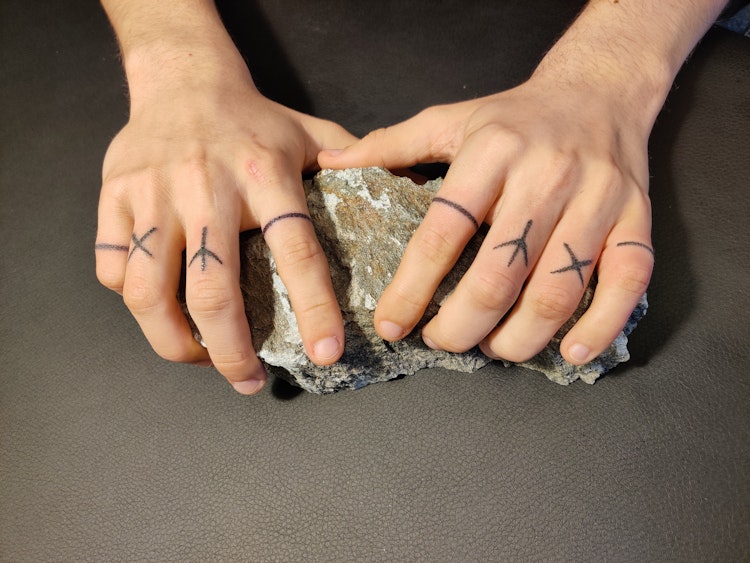

Maya Sialuk Jacobsen writes about the complexities of taking back Inuit tattoo traditions, a practice born and developed within a culture of collectivism, now practiced and re-assembled in a growing individualistic culture. Sialuk Jacobsen asks: ‘How do Inuit tattoos create both a new verbal and visual language?’
The Thule Culture developed around 1000 AD in coastal Alaska. It was a fast-moving culture spreading from the Siberian Chukotka Peninsula through Northern Alaska to the Canadian Arctic and Greenland. Biological, cultural, and linguistic evidence clearly shows that all modern Inuit descend from the Thule Culture. However, certain aspects of historic and contemporary Inuit culture predate the Thule. Traditional Inuit tattoo practices and patterns, tools, and perhaps most importantly, the intangible meaning and purpose of the practice, all appear to have roots among earlier Arctic cultures.1 The oldest of these finds is a tiny Dorset Culture mask carved in walrus tusk. The mask is a human face adorned with facial patterns similar to those used centuries later by Inuit women. The mask is dated to 1700 BC, and is thus about 2,700 years older than the Thule Culture.
Tattooing among the Inuit is a female practice that is deeply rooted in Inuit religion, where the main pillars are animism and collectivism. Inuttut — The Way Of The Human Being — is perhaps the closest name for the original religion. This encompasses the way of hunting, the way of connecting to nature and wildlife, the way of tattooing, and the way an Inuk does anything during their lifetime. ‘The Way’ refers to the intangible aspect: the spiritual concepts of maintaining a balance between Human Beings and all the ‘others’: everything that is alive, and so has spirit and life force, will, and awareness. The concept of ‘alive’ is not limited to those that breathe and bleed, but includes all things: the creek, the pebble, the creature, the plant, the weather, the emotion, and the voice. The Inuit were completely dependent on the cooperation of these life forces for survival. For the Inuit to eat, the wildlife had to be willing to let themselves be killed.
For over a thousand years, Inuit women tattooed young Inuit girls and taught them the spiritual responsibilities that would surround every aspect of their existence.
The essential ‘keeping of balance’ in Inuit belief focuses on the interplay between two worlds: Sila, the visible world where the human beings live, and Silam Aappaa, literally ‘the other Sila’, where the spirits live, and the death realms are. Silam Aappaa is invisible to regular people, and only accessible to those who have special, innate, or learned skills. Nevertheless, the two worlds are interconnected and interwoven. The spirits from Silam Aappaa rule and regulate life in Sila and so must be kept appeased through observing a staggering number of taboos and ways of conducting life’s tasks. The most significant taboos relate to death. Killing to survive, while necessary, creates imbalance and is therefore governed by a large number of rules. Women’s tattoos are an integral part of this repair of broken taboos and the birth-death-rebirth cycle.
For over a thousand years, Inuit women tattooed young Inuit girls and taught them the spiritual responsibilities that would surround every aspect of their existence. From generation to generation, the patterns remained alive. Facial amuletic patterns showed tribal affiliation, arm and leg patterns ensured prosperity through successful hunting, and hand and finger patterns kept the Ocean Spirit pleased. Tattooed dots protected the clan against vengeful spirits, while representations of plants and totems of ravens cured illness, secured easy births, or gave courage to meet one's Helping Spirits. These practices were essential parts of life among all Inuit tribes, up until European missionaries implemented variations of Christianity in our territories.
Greenland was colonised in 1721, and merely 50 years later it seems that the practice of tattooing had nearly vanished. A practice that has been continuously active for the collective lifespan of a culture is not abandoned lightly. What strong powers caused Inuit women across the North American Arctic to stop tattooing so quickly after the settlers arrived from Europe? In part, this was the result of changing beliefs. Practices that are closely connected to one religion may quickly be abandoned once a people have changed to a new faith. Christianity is the literal opposite of the original Inuit religion in many ways, and so caused the worldview to be turned upside down. The Christian worship of a Creator rather than The Creation had an immense effect on the Inuit relationship to wildlife and nature. We learned to see nature as an exploitable resource rather than a cooperation between human, wildlife, and the spirit world. Like other pre-Christian spiritual practices, tattoos were frowned upon (also by fellow Inuit who had converted), regarded as heathen, and in some cases directly banned. They no longer performed an essential task and were not necessary for survival, according to the new faith.
What was once a tradition of identical, communal tattoos has now been transformed into a catalogue used to tell the stories of individual women: their faith, their motherhood, their being Inuk.
The same amuletic patterns were traditionally tattooed on the same body parts by all Canadian Central Inuit and West Greenlandic Inuit tribes, but each subtribe had specific combinations and placements of the patterns, varying according to hunting methods, landscapes, and types of wildlife in their territories. This complexity of pattern use has proven to be a challenge today, as Inuit tattooing is being revived all over Arctic North America. Because the practice was abandoned and the continuity disrupted for 100-300 years, the traditional knowledge was almost lost; it requires extensive research to understand the details of pattern combinations for each tribe.
In 2017, I arrived in Nuuk, the capital of Greenland. It was the first time in two decades that I had come back home. I was a trained tattooer with many years of experience, had travelled the world and met many different Indigenous peoples working with their own tattoo traditions, and learned about the circumstances surrounding how they reimplemented those practices. It was seven years into my research of Inuttut Kakiornerit (Inuit tattoo traditions), and my folders were filled with patterns collected from archives and ethnographic literature on Inuit from the North American Arctic. My notes were rich with analysis of the meaning and purpose of the tattoos.
Illustrations by Maya Sialuk Jacobsen.
Following a two-year tattoo re-emergence project based in Alaska, I had some experience in reimplementation of Inuit tattooing practices, and an idea of the pitfalls that could be expected. The historical loss of language surrounding the practice was one significant issue, and the loss of framework and rules was another. Both these facets are extremely important for creating the best circumstances for the tattoo practice, to give access to a deeper understanding of who we once were, and to ensure cultural preservation and halt the loss of culture. Strong forces worked against this effort, including the impatient speed of the information era that we live in. Those of us working to truly understand and reinvigorate past traditions simply cannot work as fast as misinformation can be spread on the Internet.
The language part was relatively easy to solve, as Inuit languages are descriptive and easy to adapt to the practice. I found that most people needed a Western way of categorising the tattoos, designating and naming them quite strictly, rather than using the Inuit way of seeing things as fluid and interconnected. I was forced to name patterns rather than simply describe them — which in itself is a Western approach necessary to make information accessible.
As modern people, Inuit are going through the same rapid individualisation as the rest of contemporary Western society, thereby creating an ever-increasing gap between us and the collectivism that was once a tool for survival. Consequently, today there is a desire for Inuit tattoos to reflect individual rather than collective identity. What was once a tradition of identical, communal tattoos has now been transformed into a catalogue used to tell the stories of individual women: their faith, their motherhood, their being Inuk.
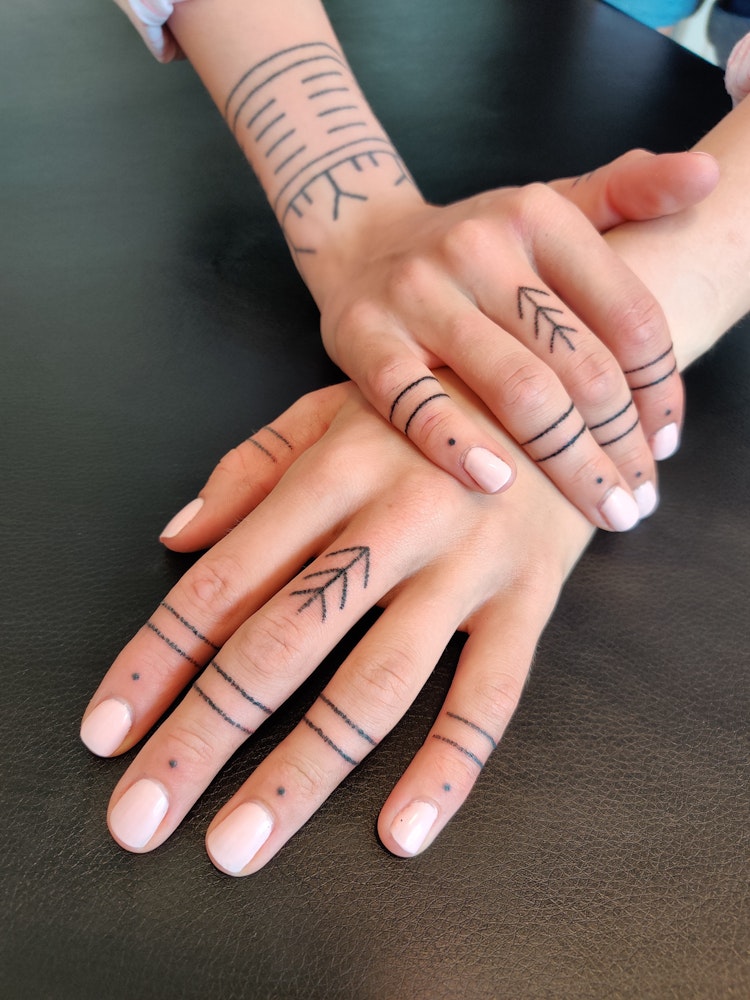
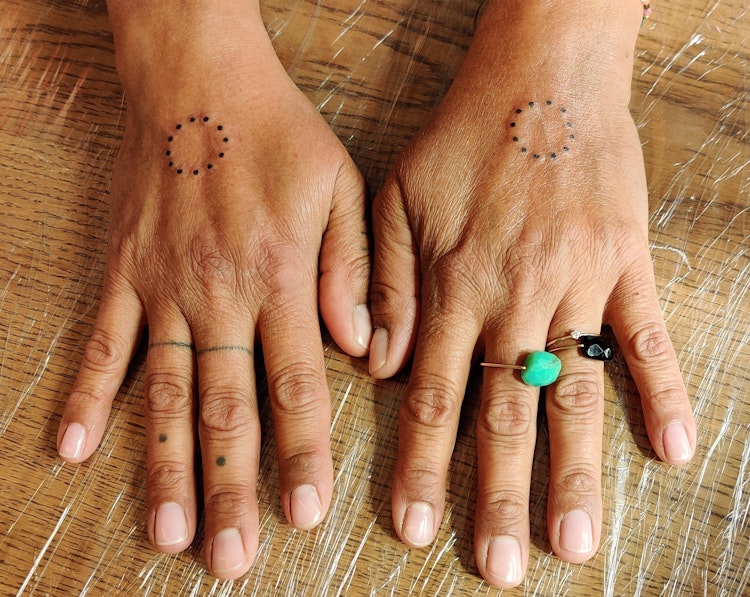
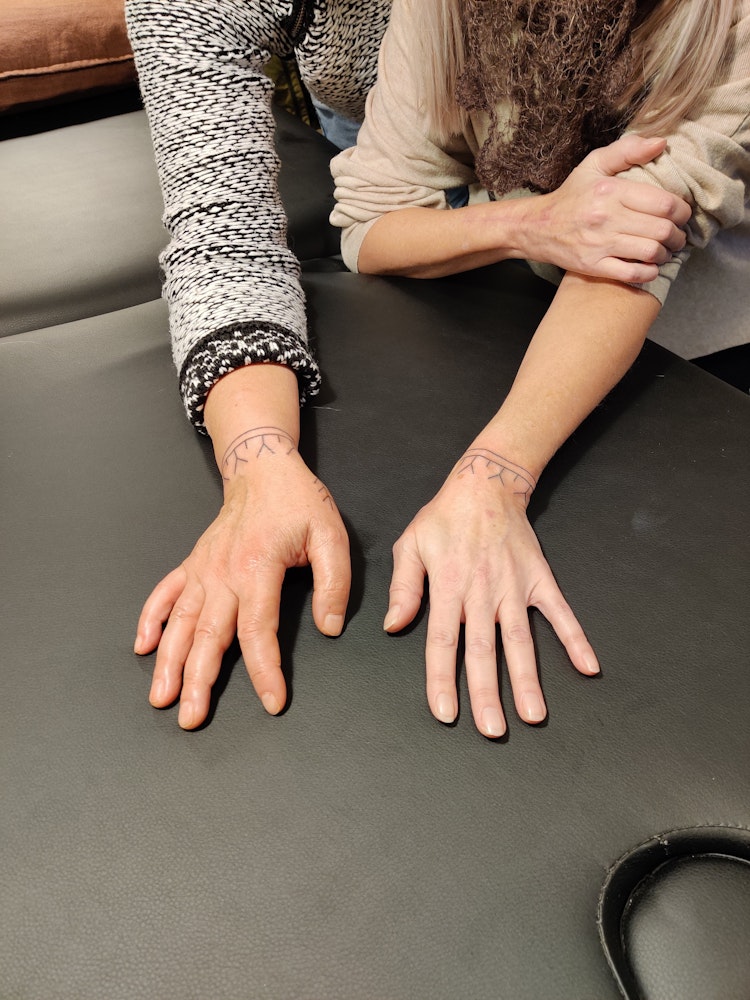
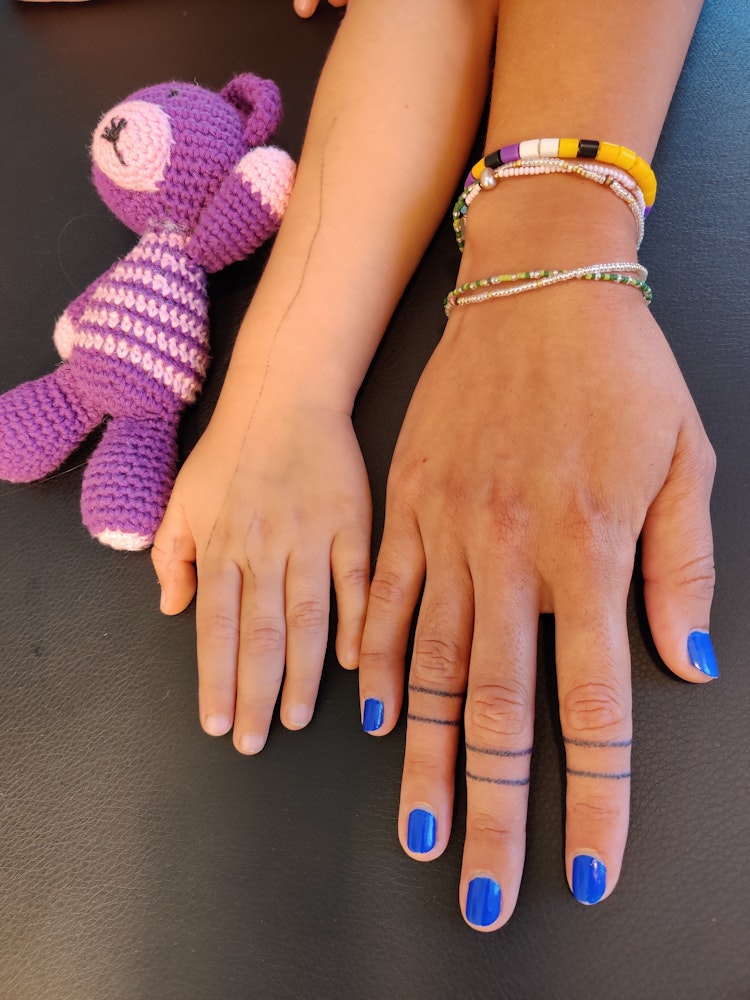
Traditional Inuit facial tattoo patterns are particularly fragmented today, as the entire set of chin, cheeks, forehead, and eyes is no longer deemed fitting in a society where they clash with Western beauty standards. Rather than choosing 11-22 chin lines, most women today get only 1-3 of them. These patterns have a traditional design that is easy to divide into smaller sections, allowing for their modern look. By comparison, the Maori of Aotearoa have more intricate designs embedded in their facial tattoos, which cannot be divided into smaller fragments. Admittedly, it has a more powerful impact meeting a group of Maori with full Moko covering their entire faces. It reflects a formidable dedication to their heritage. All it takes is courage to be the first.
Today in our Westernised and Christianised existence, many Inuit fail to recognise tattoos as deep heritage. Patterns that were infused with life and spirit through at least 4,000 years of use have — over just a decade of revival efforts — to large extent been disconnected from their original spirituality and purpose, reduced simply to marking Inuit identity. The patterns from our deep past have been redrawn, individualised, and often mistakenly labelled, leaving our people as far from understanding their real heritage as before. There is no doubt that it is due to the loss of the original framework that surrounded the practice. A new framework will grow in time. We are new at this, and there is so much to unlearn and relearn.
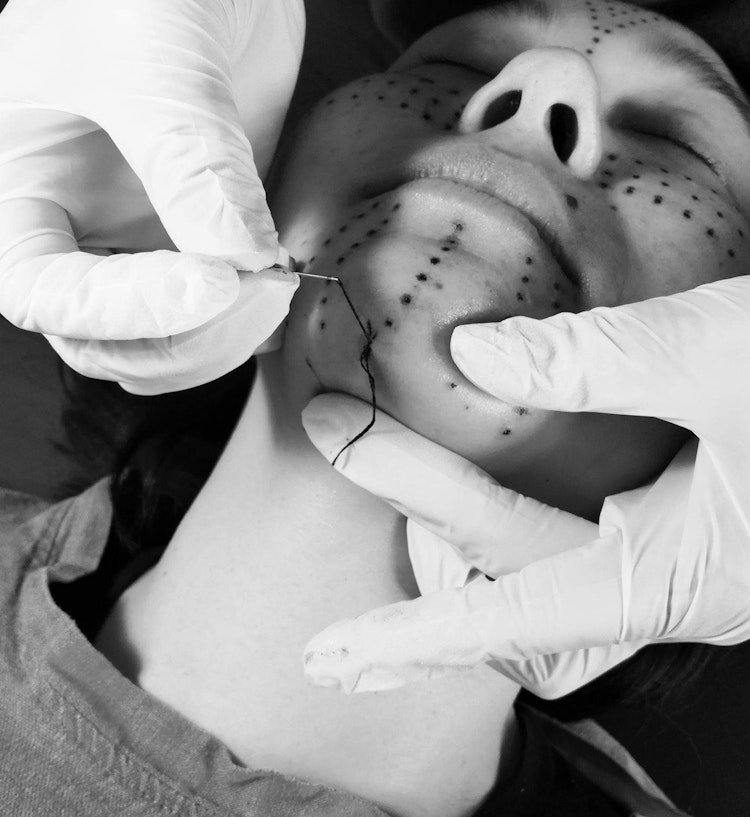
Inuit tattooing has taken a political shape. More than any other aspect of our cultural heritage, tattooing is used today as a marker of activism and the demand for decolonisation. Cultural revival is by its very nature political and uncomfortable for the colonial viewer. A culture member doing research in their own culture is a colonised human taking back lost culture, which is an act of defiance. As a result, even 71 years since Greenland has been a Danish colony, there are times when my research on Inuit tattooing has been deemed politicised and aggressive.
Inuuvungut! — We are humans, we are Inuit, we exist, we are alive!
The post-colonial existence of today's Inuit is challenging. Greenlandic professor Robert Petersen wrote: ‘One kind of mental colonialism occurred due to the fact that colonisation in Greenland was established hand-in-hand with the Lutheran mission.’2
The colony offered a severe societal change in structure by establishing trade stations and replacing Inuit collectivism with systemic hierarchy. Inuit abandoned the semi-nomadic life and settled in the towns that grew around the trade. After three centuries of Christianity, many Inuit seem to have lost sight of what part of our mindset and behaviour is Inuit, and what is Westernised and Christianised. Our old values are changed, but at the same time the new, Western values are not truly engrained. It is a confusing limbo existence. We honour hunting and see it as a cultural marker, yet the traditional hunters are the lowest in the societal hierarchy. We honour our culture and the oral tradition, yet we allow myths and legends to be forgotten and only repeat a few key, romanticised stories. The deeper meaning is forgotten, and the words are polished and made less brutal, less sexual, and less offensive to the Christian ear. The deep oral traditions consist of more than 2,000 myths and legends that teach us how to be Inuit and how to exist in these wild landscapes, in a relationship with Nature and all the spirits.
The work continues. The hope thrives. We will settle as a people and find the balance between the new and the old. We will keep that balance as our ancestors kept the balance between Sila and Silam Aappaa in every little task of daily life.
Inuuvungut! — We are humans, we are Inuit, we exist, we are alive!
Click on the image to see captions.











